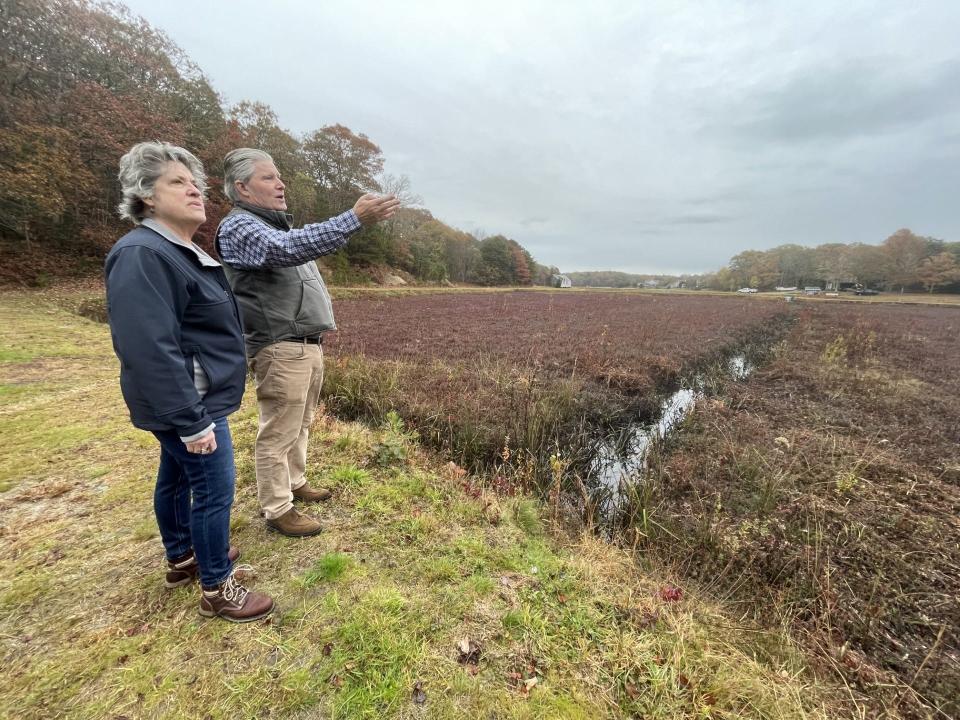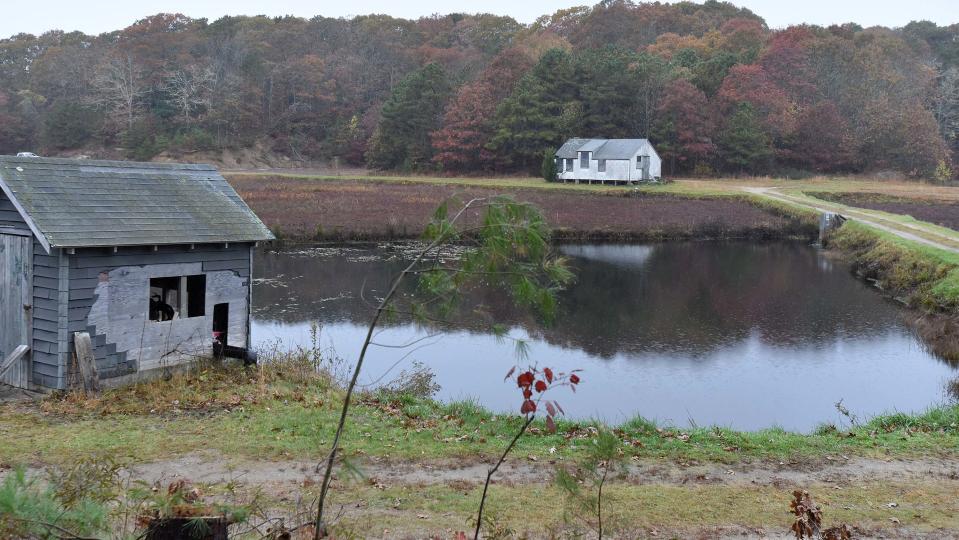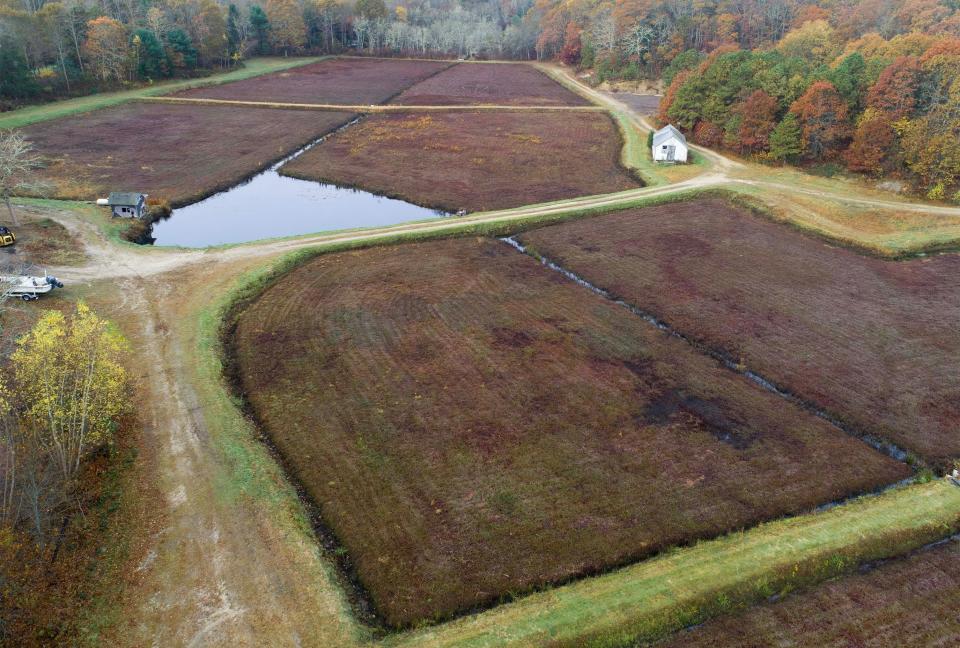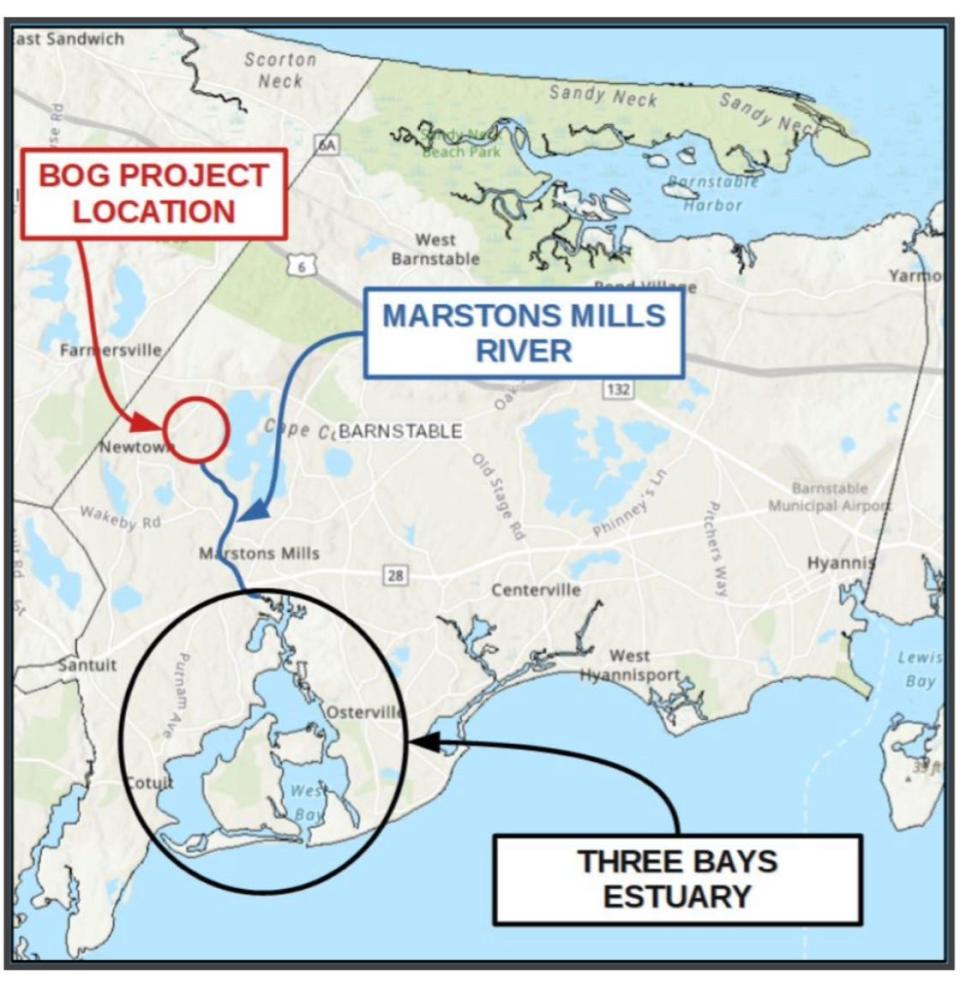'Big, big growth of algae.' Restored Marstons Mills wetlands to lessen nitrogen pollution
MARSTONS MILLS — In the headwaters of the Marstons Mills River, 78 acres of cranberry bogs and adjacent uplands are tucked in along Bog Road and River Road.
The bogs have given up their berries this season, and await the next growing season. For that acreage, next season will be the last.
The land, purchased this summer by the Barnstable Clean Water Coalition and Three Bays Preservation with a $1.6 million grant from the state Executive Office of Energy and Environmental Affairs, represents a shift in the landscape of Cape Cod cranberry farming.
Faced with increased competition, higher costs, lower prices, labor shortages, and climate change, some Cape farmers are selling their bogs. Some, ready to retire, are letting go of all their bogs. Others are selling a portion, then using the proceeds to retool for higher yield cranberry varieties on less land.

Eager buyers wait in the wings, too, such as the Barnstable nonprofit that wants to restore bogs back to natural, wetland environments — to eliminate nitrogen pollution downstream.
"In the 1860s, 1870s, the cranberry bogs saved Cape Cod economically," coalition Executive Director Zenas Crocker said in November during a tour at the bogs. "Our hope is that, now, some of them will help restore Cape Cod environmentally."
The bogs purchased by the Clean Water Coalition and Three Bays Preservation are part of the Marstons Mills River ecological restoration project, which aims to reduce nitrogen flow downriver and ultimately improve water quality in the Three Bays estuary on the Cape's southern shoreline. The properties at 110 Bog Road, now owned by the nonprofit, and 710 River Road, privately owned, comprise the project, according to a document filed with the Barnstable Registry of Deeds.
The 710 River Road acreage is owned by Joe Keating.
"Joe is a cooperative neighbor and farmer who has been very helpful with the project. The 'treated' water — post restoration —will continue to flow through Joe’s land and swamp area, about 11 acres, as it does now," Crocker explained.
In theory, the native plants that once thrived in the bog areas, prior to cranberry growing, will be revitalized, and as part of their growth the plants will absorb nitrogen and thereby cleanse water before it flows south. The river's headwaters are just west of the coalition's newly acquired property on River Road, according to Crocker.
The return of cranberry bogs to natural wetlands on Cape Cod has already been undertaken on the Coonamessett River and Childs River in Falmouth. "But nobody has really done a full-on restoration with the main purpose being water cleansing," Crocker said.
Work could start as soon as 2025.

Why choose a bog restoration?
About 3 million gallons of water per day flow through the Marstons Mills bogs, and much of it is affected by groundwater that has become "contaminated by all of these houses" that are not connected to sewers, Crocker said.
"We tested the Marstons Mills River and found elevated antibiotics and elevated antidepressants. So we know without a doubt where all the nitrogen is coming from," he said.
Returning unused or unwanted bogs back to wetlands is preferable to abandoning them — where woody areas of invasive vegetation and scrub pine can develop. With the wetlands restored, he said, "you can treat this water here before it gets to the salt water."
Three Bays estuary is severely degraded by nitrogen and bacteria resulting in poor water quality, impaired habitat, and closures of beaches and shellfish areas, according to the Association to Preserve Cape Cod. With nitrogen flowing down the rivers, every south-facing Cape Cod estuary is gradually being poisoned, "and nature reacts with big, big growth of algae" Crocker said.
In Popponesset Bay in Mashpee, west of Three Bays estuary, a layer of smelly black sludge on the bottom is the result of "decades of algae growing and dying, growing and dying," he said. That is why shellfish won't grow and why eel grass, a key component of a healthy estuarine habitat, won't grow, Crocker said. It may also be the reason there are larger, and longer-lasting jellyfish blooms, he said.
Slow the river down
In an ideal future, the restored wetlands at the Marstons Mills project should have native plants like wool grass and cattails, a slow-moving, meandering river with beaver dams, shallow ponds and wildlife.
The water should move from the head of the river to the estuary in about 48 hours or more, rather than the five to six hours it takes now.
But how to make that happen?
Workers will fill drainage ditches used by cranberry farmers, grade bog surfaces, remove water control structures and reconstruct natural stream channels.
A backhoe will pull up the vestiges of cranberry growing on the bogs — a mat of sand and cranberry vines about two-to-three feet deep. Beneath that mat will be about 10 to 50 feet of peat moss, Crocker said. "The amazing thing is seeds from the plants from 150 to 200 years ago are still there and will germinate."

Those are the plants that are to be restored and nurtured in the project, and recruited to do the water cleansing.
The Marstons Mills project is just one example of a growing list of bog restorations on Cape.
“It is a major trend and for good reason — restoring cranberry bogs to their natural state benefits the environment, encourages the return of wildlife and rare species habitats and contributes to the health of our waterways,” said Neal Price, a senior hydrogeologist at Horsley Witten Group, Inc.
The advantage of doing such restorations, he noted, is that they are relatively quick to do compared to sewering and septic system replacements and are "a huge benefit for relatively little money."
Horsley Witten Group most recently announced a town-and-state partnership to restore the retired Chop Chaque cranberry bogs in Mashpee, a town-owned parcel, to freshwater wetlands.
What about Cape cranberry farmers? 'It's challenging.' With mounting pressures, Cape Cod cranberry farming spurred to adapt
Will this trend put cranberry farmers out of work?
Some cranberry farmers are glad to turn over their retiring bogs to restorations, but others are disheartened to see the Cape's cranberry fields diminished. They worry some of their brethren may feel pressured to bow out, and too much will be relinquished.
On the contrary, Crocker said conservationists want to work with the farmers who are transitioning away from farming or toward newer, less land intensive cultivars.
"Farmers may say, 'I don't need that bog so much, I'm going to let it go.' We're saying, 'OK, if you're going to do that, what's the best way to restore that back to what is natural?" he said.

The Marstons Mills property at 110 Bog Road, with 60 acres, has an appraised value of $537,500, according to town assessing records. The nonprofit bought about 47 of those acres, which Crocker said "comprise the heart of the restoration project." The sale by Erik Hamblin to the nonprofit for $750,000 occurred June 29, according to registry records.
The nonprofit also bought 14 acres at 946 and 948 River Road for $585,000 on the same day. Conservation restrictions held by the Barnstable Land Trust were recorded for all three properties on Aug. 24, according to the registry.
Price, with Horsley Witten Group, said land uses on Cape have changed significantly from 100 years ago. Cranberry cultivation, he said, was "clearly what the Cape was from the mid 1800s to about the mid '60s, before tourism was a thing."
Looking at old maps, he said, "you can see in the 1860s there were almost no cranberry bogs, and they were almost everywhere you looked in the 1930s." At one time, Price noted, the Quashnet River in Falmouth "was the largest and longest continuous cranberry system in the world."
When a farmer determines a bog can no longer be of use, he said, "we should embrace the opportunity when we have it."
Now there's grant money for retired cranberry bogs to be restored as wetlands, so bog owners get some money and towns get environmental restoration, Price said. "It's a win-win."
Heather McCarron writes about climate change, environment, energy, science and the natural world, in addition to news and features in Barnstable and Brewster. Reach her at hmccarron@capecodonline.com, or follow her on X @HMcCarron_CCT
Thanks to our subscribers, who help make this coverage possible. If you are not a subscriber, please consider supporting quality local journalism with a Cape Cod Times subscription. Here are our subscription plans.
This article originally appeared on Cape Cod Times: Barnstable clean water group uses $1.6M state grant to retool bogs

